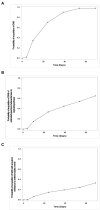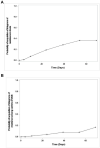Dynamics of the digestive acquisition of bacterial carriage and integron presence by French preterm newborns according to maternal colonization: The DAIR3N multicentric study
- PMID: 36998410
- PMCID: PMC10043237
- DOI: 10.3389/fmicb.2023.1148319
Dynamics of the digestive acquisition of bacterial carriage and integron presence by French preterm newborns according to maternal colonization: The DAIR3N multicentric study
Abstract
Objectives: The study aimed to describe the dynamics and risk factors of Gram-negative bacteria (GNB) acquisition in preterm infants.
Methods: This prospective multicenter French study included mothers hospitalized for preterm delivery and their newborns, followed until hospital discharge. Maternal feces and vaginal fluids at delivery, and neonatal feces from birth to discharge were tested for cultivable GNB, potential acquired resistance, and integrons. The primary outcome was the acquisition of GNB and integrons in neonatal feces, and their dynamics, evaluated by survival analysis using the actuarial method. Risk factors were analyzed using Cox models.
Results: Two hundred thirty-eight evaluable preterm dyads were included by five different centers over 16 months. GNB were isolated in 32.6% of vaginal samples, with 15.4% of strains producing extended-spectrum beta-lactamase (ESBL) or hyperproducing cephalosporinase (HCase), and in 96.2% of maternal feces, with 7.8% ESBL-GNB or HCase-GNB. Integrons were detected in 40.2% of feces and 10.6% of GNB strains. The mean (SD) length of stay of newborns was 39.5 (15.9) days; 4 died in the hospital. At least one infection episode occurred in 36.1% of newborns. The acquisition of GNB and integrons was progressive from birth to discharge. At discharge, half of newborns had ESBL-GNB or HCase-GNB, independently favored by a premature rupture of membranes (Hazard Ratio (HR), 3.41, 95% confidence interval (CI), 1.71; 6.81), and 25.6% had integrons (protective factor: multiple gestation, HR, 0.367, 95% CI, 0.195; 0.693).
Conclusion: In preterm newborns, the acquisitions of GNB, including resistant ones, and integrons are progressive from birth to discharge. A premature rupture of membranes favored the colonization by ESBL-GNB or Hcase-GNB.
Keywords: Integrons; antimicrobial resistance; digestive acquisition; gram-negative bacteria; preterm newborn infant; resistance markers.
Copyright © 2023 Patry, Bothorel, Labrunie, Renesm, Lehours, Benard, Dubois, Ponthier, Meyer, Norbert, Villeneuve, Jouvencel, Leysenne, Chainier, Luce, Grélaud, Ploy, Bedu and Garnier.
Conflict of interest statement
The authors declare that the research was conducted in the absence of any commercial or financial relationships that could be construed as a potential conflict of interest.
Figures



References
-
- Ancel P. Y., Goffinet F., Kuhn P., Langer B., Matis J., Hernandorena X., et al. . (2015). Survival and morbidity of preterm children born at 22 through 34 weeks' gestation in France in 2011: results of the EPIPAGE-2 cohort study. JAMA Pediatr. 169, 230–238. doi: 10.1001/jamapediatrics.2014.3351 - DOI - PubMed
LinkOut - more resources
Full Text Sources

